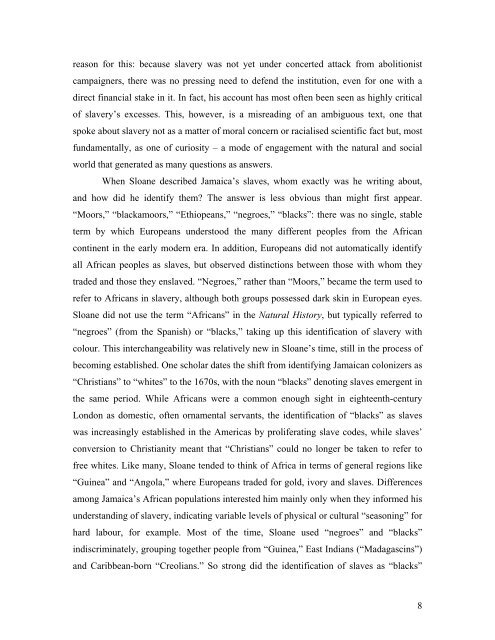Slavery in the Cabinet of Curiosities: Hans ... - British Museum
Slavery in the Cabinet of Curiosities: Hans ... - British Museum
Slavery in the Cabinet of Curiosities: Hans ... - British Museum
Create successful ePaper yourself
Turn your PDF publications into a flip-book with our unique Google optimized e-Paper software.
eason for this: because slavery was not yet under concerted attack from abolitionist<br />
campaigners, <strong>the</strong>re was no press<strong>in</strong>g need to defend <strong>the</strong> <strong>in</strong>stitution, even for one with a<br />
direct f<strong>in</strong>ancial stake <strong>in</strong> it. In fact, his account has most <strong>of</strong>ten been seen as highly critical<br />
<strong>of</strong> slavery’s excesses. This, however, is a misread<strong>in</strong>g <strong>of</strong> an ambiguous text, one that<br />
spoke about slavery not as a matter <strong>of</strong> moral concern or racialised scientific fact but, most<br />
fundamentally, as one <strong>of</strong> curiosity – a mode <strong>of</strong> engagement with <strong>the</strong> natural and social<br />
world that generated as many questions as answers.<br />
When Sloane described Jamaica’s slaves, whom exactly was he writ<strong>in</strong>g about,<br />
and how did he identify <strong>the</strong>m? The answer is less obvious than might first appear.<br />
“Moors,” “blackamoors,” “Ethiopeans,” “negroes,” “blacks”: <strong>the</strong>re was no s<strong>in</strong>gle, stable<br />
term by which Europeans understood <strong>the</strong> many different peoples from <strong>the</strong> African<br />
cont<strong>in</strong>ent <strong>in</strong> <strong>the</strong> early modern era. In addition, Europeans did not automatically identify<br />
all African peoples as slaves, but observed dist<strong>in</strong>ctions between those with whom <strong>the</strong>y<br />
traded and those <strong>the</strong>y enslaved. “Negroes,” ra<strong>the</strong>r than “Moors,” became <strong>the</strong> term used to<br />
refer to Africans <strong>in</strong> slavery, although both groups possessed dark sk<strong>in</strong> <strong>in</strong> European eyes.<br />
Sloane did not use <strong>the</strong> term “Africans” <strong>in</strong> <strong>the</strong> Natural History, but typically referred to<br />
“negroes” (from <strong>the</strong> Spanish) or “blacks,” tak<strong>in</strong>g up this identification <strong>of</strong> slavery with<br />
colour. This <strong>in</strong>terchangeability was relatively new <strong>in</strong> Sloane’s time, still <strong>in</strong> <strong>the</strong> process <strong>of</strong><br />
becom<strong>in</strong>g established. One scholar dates <strong>the</strong> shift from identify<strong>in</strong>g Jamaican colonizers as<br />
“Christians” to “whites” to <strong>the</strong> 1670s, with <strong>the</strong> noun “blacks” denot<strong>in</strong>g slaves emergent <strong>in</strong><br />
<strong>the</strong> same period. While Africans were a common enough sight <strong>in</strong> eighteenth-century<br />
London as domestic, <strong>of</strong>ten ornamental servants, <strong>the</strong> identification <strong>of</strong> “blacks” as slaves<br />
was <strong>in</strong>creas<strong>in</strong>gly established <strong>in</strong> <strong>the</strong> Americas by proliferat<strong>in</strong>g slave codes, while slaves’<br />
conversion to Christianity meant that “Christians” could no longer be taken to refer to<br />
free whites. Like many, Sloane tended to th<strong>in</strong>k <strong>of</strong> Africa <strong>in</strong> terms <strong>of</strong> general regions like<br />
“Gu<strong>in</strong>ea” and “Angola,” where Europeans traded for gold, ivory and slaves. Differences<br />
among Jamaica’s African populations <strong>in</strong>terested him ma<strong>in</strong>ly only when <strong>the</strong>y <strong>in</strong>formed his<br />
understand<strong>in</strong>g <strong>of</strong> slavery, <strong>in</strong>dicat<strong>in</strong>g variable levels <strong>of</strong> physical or cultural “season<strong>in</strong>g” for<br />
hard labour, for example. Most <strong>of</strong> <strong>the</strong> time, Sloane used “negroes” and “blacks”<br />
<strong>in</strong>discrim<strong>in</strong>ately, group<strong>in</strong>g toge<strong>the</strong>r people from “Gu<strong>in</strong>ea,” East Indians (“Madagasc<strong>in</strong>s”)<br />
and Caribbean-born “Creolians.” So strong did <strong>the</strong> identification <strong>of</strong> slaves as “blacks”<br />
8

















